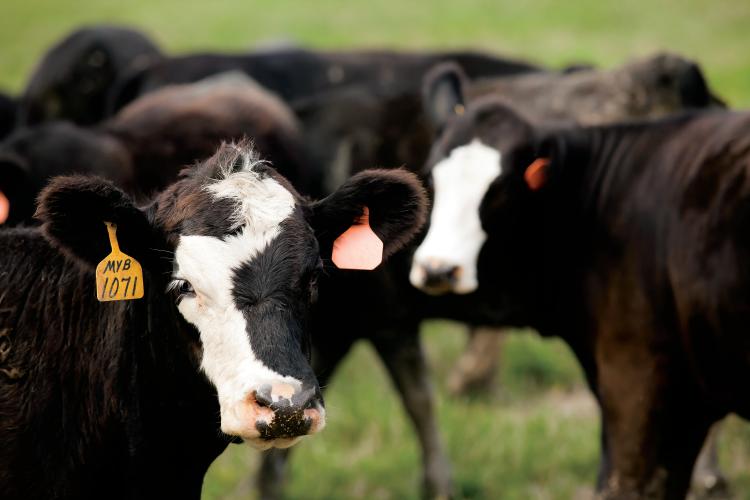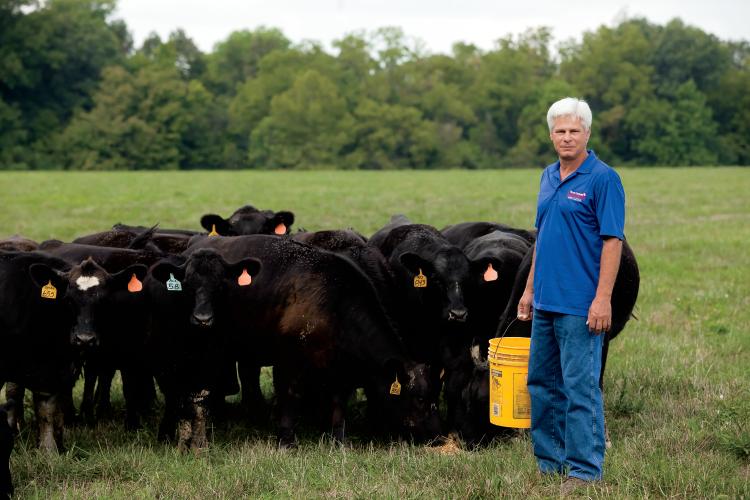Home > Kentucky > Kentucky Crops & Livestock > Kentucky’s CPH45 Cattle Health Program Helps Better the State’s Bovines
Kentucky’s CPH45 Cattle Health Program Helps Better the State’s Bovines

In cattle farming, reputation is everything. And in the late 1970s, Kentucky cattle were rapidly becoming the Chevy Corvairs of the national beef industry.
The problem? Calves sent from Kentucky farms to western feedlots were too often sick or dying before harvest. Kentucky needed a solution – fast.
Officials and farmers came up with the Certified Pre-Conditioned for Health (45) program, which better prepares calves for back grounding or feedlots.
Thirty-three years later, the CPH45 blue tag in the center of a cow’s right ear means not only that the animal is healthy, but that it is likely to command a higher price at sales.
“I think it has really helped the industry,” says Preston Seals, a Berea farmer with around 60 cows certified through CPH45. “I hear a lot of people at the feedlots make comments that they like to see those blue tags coming in.”
Without CPH45, calves are often sold “green,” meaning they are sent to a buyer immediately after being weaned. They go to a feedlot having only had food from their mothers and water from ponds. When they get to a lot, they’re stressed from being away from their mothers and traveling long distances and are exposed to countless new animals that could harbor new diseases. They’re also offered food from bunks and water from automatic waterers for the first time, and the animals are typically dangerously slow to adapt.

With CPH45 certification, farmers are required to hold on to the calves for 45-60 days (the average is 50) after weaning. Cows are vaccinated and trained to eat bunk feed and drink from automatic waterers. They are also castrated, dehorned, dewormed and get a steady diet of important minerals. The cattle still go through some stress. But after two weeks or so separated from the mother, they’re usually able to adapt.
“This program is a little bit different from some; some just give them a round of shots,” says Roy Burris, extension beef specialist and an extension professor for animal sciences at the University of Kentucky. “This program is meant to do everything we possibly can to improve their chances in a feedlot.”
All that added preparation can mean some nice black numbers on balance sheets. In a good year, a CPH45 farmer can add $50 to $100 in value to a typical calf.
For Seals, who keeps 50 or 60 cows, that can mean as much as $6,000.
“That’s real money,” Seals says. “And that’s money that you would have left on the table.”
The program especially adds value for small farmers who can’t command the higher prices that large lots of cattle get at market. Kentucky officials started offering a marketing component that allows CPH45 cattle to be grouped together at sales. Cows from several CPH45 farmers can be grouped together for buyers who will pay a premium for large lots.
There’s always some risk after putting in more work and money that beef prices will fall at the end of 45 days. But in 33 years, Burris says CPH45 farmers have come out behind only three times, usually because of some kind of national problem such as a bovine spongiform encephalopathy scare.
“Three years that have lost money out of 33 years,” Burris says. “That’s a pretty good track record.”

Those odds feel good to Troy Ellis, a CPH45 farmer in Hadley, who keeps about 120 cows. He estimates that after extra feed and materials, he brings in $100-$150 and profits $50-$100 per calf. He said he’s only come out behind in two out of the last 10 years.
“That’s pretty good on any farming project,” Ellis says.
Ellis suspects that standards similar to CPH45 will become more rule than exception. More and more buyers and consumers are going to want products from conditioned, well-treated cattle.
Seals feels the same way. He said he doesn’t just participate because of the added value per calf.
“I’m trying to furnish the food service industry out there with a good product,” Seals says. “I’m putting good beef out there for the consumer. I think I can almost guarantee that the beef that comes off my farm is healthy and clean and about the best you can find.”



